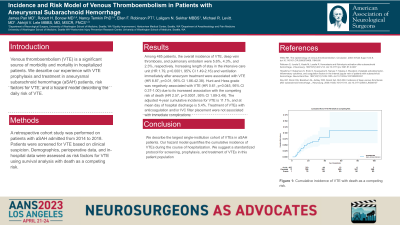Incidence and Risk Model of Venous Thromboembolism in Patients with Aneurysmal Subarachnoid Hemorrhage
Friday, April 21, 2023


James Pan, MD
Resident Physician
University of Washington
Seattle, Washington, United States
ePoster Presenter(s)
Introduction: Venous thromboembolism (VTE) is a significant source of morbidity and mortality in hospitalized patients. We describe our experience with VTE prophylaxis and treatment in aneurysmal subarachnoid hemorrhage patients, risk factors for VTE development, and a robust hazard model providing insight into the probability of per-hospital day risk of VTE.
Methods: A retrospective cohort study was conducted and included 485 consecutive patients admitted to our academic medical center from 2014 to 2018. Patients were screened for VTE based on clinical suspicion. Patient demographics, perioperative data, and in-hospital data were assessed as risk factors for VTE using survival analysis with death as a competing risk.
Results: Among 485 patients, the incidence of VTE was 5.6%. The incidence for DVT is 4.3% and PE is 2.3%. Increasing length of stay (LOS) in the intensive care unit (ICU) (HR 1.79, p< 0.0001, 95% CI 1.49-2.16) and ventilation immediately after aneurysm treatment were associated with VTE (HR 8.87, p< 0.01, 95% CI 1.86-42.38). Hunt and Hess grade was negatively associated with VTE (HR 0.61, p=0.045, 95% CI 0.37-1.00). The cumulative incidence for VTE at mean day of hospital discharge is 5.4%, and for long-term hospitalizations is 11.1%. Treatment of VTEs with anticoagulation and/or IVC filter placement was not associated with immediate complications.
Conclusion : We describe the largest single-institution cohort of VTEs in aSAH patients. Our hazard model is useful for quantifying the cumulative risk of VTEs during the course of hospitalization. We confirm some of the risk factors for VTE as described previously but also found conflicting evidence of other risk factors when considering death as a competing risk.
Methods: A retrospective cohort study was conducted and included 485 consecutive patients admitted to our academic medical center from 2014 to 2018. Patients were screened for VTE based on clinical suspicion. Patient demographics, perioperative data, and in-hospital data were assessed as risk factors for VTE using survival analysis with death as a competing risk.
Results: Among 485 patients, the incidence of VTE was 5.6%. The incidence for DVT is 4.3% and PE is 2.3%. Increasing length of stay (LOS) in the intensive care unit (ICU) (HR 1.79, p< 0.0001, 95% CI 1.49-2.16) and ventilation immediately after aneurysm treatment were associated with VTE (HR 8.87, p< 0.01, 95% CI 1.86-42.38). Hunt and Hess grade was negatively associated with VTE (HR 0.61, p=0.045, 95% CI 0.37-1.00). The cumulative incidence for VTE at mean day of hospital discharge is 5.4%, and for long-term hospitalizations is 11.1%. Treatment of VTEs with anticoagulation and/or IVC filter placement was not associated with immediate complications.
Conclusion : We describe the largest single-institution cohort of VTEs in aSAH patients. Our hazard model is useful for quantifying the cumulative risk of VTEs during the course of hospitalization. We confirm some of the risk factors for VTE as described previously but also found conflicting evidence of other risk factors when considering death as a competing risk.
